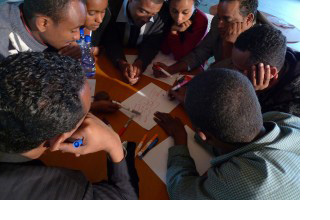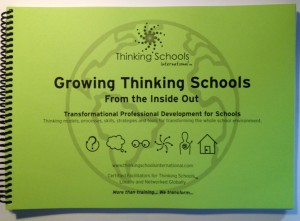


 Thinking Schools Accreditation Process (TSAP)
Thinking Schools Accreditation Process (TSAP)
Working toward becoming a Thinking School is a developmental process, one that continues to mature and deepen over time. Schools on this journey generally pass through three stages, Level 1—Emerging, Level 2—Integrating, and Level 3—Sustaining.

In the formal accreditation process, a member of the accreditation team certified by Thinking Foundation serves as an Accrediting Partner (AP) for each school. As a school community begins the process, artifacts are collected in the form of videos, photos, audio interviews, surveys, student and adult documents, etc., toward the creation of a school wide TSAP Portfolio. Ultimately, with guidance provided by the AP, the school submits a Thinking Schools Portfolio for review, publication and web based distribution to others in the Thinking Schools Network around the world. Depending on the planning and development of each school, the process may take between 18 months to several years to complete. Advanced accreditation is also offered in order to sustain the evolving practices and vision of each school.
A school might elect to wait until it has progressed through the early stages of development as a Thinking School before it engages in the formal accreditation process. Some schools, however, may be interested in participating in a formative review process in order to have the added benefit of feedback along the way. Participating in a formative review process provides schools with immediate and timely input from accrediting partners that can affirm, energize and guide the school’s development as it progresses toward its vision.
Schools in the early stages of the journey, generally Levels 1 & 2, that elect to engage in a formative review process are also required to use the portfolio template to provide information to the accrediting partner. However, the documentation of progress across the 5 Key Areas for Reflection and the 15 Criteria needed for recognition of attainment at this stage is not as extensive as that required in the formal accreditation process. Schools, though, will be asked to also submit a powerpoint presentation, including embedded video, which highlights key features of its development as a Thinking School and its plans for continued growth.
The Thinking Schools Developmental Levels
Level 1—Emerging
 Schools at this level have formally initiated the process of developing as a Thinking School. A “drive team” has been formed representing a broad spectrum of stakeholders from the school community and an initial plan of action has been designed. Professional learning opportunities have been undertaken to engage the school community in forming its identity as a Thinking School. Professional learning opportunities in specific pathways in student-centered models have also been introduced and these models have begun to be used in the classrooms and the school as a whole.
levels DOC.
Schools at this level have formally initiated the process of developing as a Thinking School. A “drive team” has been formed representing a broad spectrum of stakeholders from the school community and an initial plan of action has been designed. Professional learning opportunities have been undertaken to engage the school community in forming its identity as a Thinking School. Professional learning opportunities in specific pathways in student-centered models have also been introduced and these models have begun to be used in the classrooms and the school as a whole.
levels DOC.
Level 2—Integrating
At this stage, schools are continuing to refine its practices and use of student-centered models for developing thinking, inquiry-based learning and dispositions associated with successful learners. Evidence of the integrated use of these practices is apparent both in how they are used together and also in the way they have become part of the practices used throughout the school and across roles and ages.
Levels 1 and 2 are the formative stages during which schools are forming their identity as a Thinking School and introducing, expanding and refining their repertoire of practices. Schools at these levels can elect to work with a Reflective Coach (RC) to assist them in moving thoughtfully toward formal accreditation. It is recommended that at each of these two levels, schools work with a Reflective Coach for a minimum of 3 formal contact times during the year. The RC guides schools in the use of the 5 Key Areas for Reflection and the 15 Criteria as the school develops its plan for becoming a Thinking School and designs its approach for documenting its work.
Level 3—Sustaining
Level 3 is the point at which a strong foundation has been established, a clear sense of purpose and intention has become evident in the school, and the structures and processes are in place through which the school can continue to embed, deepen and sustain its efforts. It is at this stage, too, that a school becomes a resource to other schools on their journey of becoming a Thinking School.
Schools at Level 3, while continuing to grow and develop as a Thinking School, demonstrate a consistent level of attainment across all 5 Key Areas for Reflection and the 15 Criteria associated with those areas.
The Formal Accreditation Process
The formal Thinking Schools Accreditation Process (TSAP) is an opportunity for schools to engage in a systematic, highly descriptive, enquiry process focused on the 5 Key Areas for Reflection and the 15 Criteria. The 5 Key Areas for Reflection and 15 Criteria provide the guidelines through which a school and its accrediting partner can make determinations regarding the schools development as a Thinking School. The primary purpose of this process is for the school to use the information they generate to continue to inform, guide, and inspire their ongoing development as a thinking school. The steps of the process are Initiation; Preparation; Self-Study; Accrediting Partner Review; Action Plan; and Dissemination.
In the formal accreditation process, a member of the accreditation team certified by Thinking Foundation serves as an Accrediting Partner (AP) for each school. As a school community begins the process, artifacts are collected in the form of videos, photos, audio interviews, surveys, student and adult documents, etc., toward the creation of a school wide TSAP Portfolio. Ultimately, with guidance provided by the AP, the school submits a Thinking Schools Portfolio for review, publication and web based distribution to others in the Thinking Schools Network around the world. Depending on the planning and development of each school, the process may take between 18 months to several years to complete. Advanced accreditation is also offered in order to sustain the evolving practices and vision of each school.
The visual sequence above provides an overview of the Thinking Schools Accreditation Process. After a school has made the decision to journey on the path to develop as a Thinking School and formed a Drive Team to lead this effort, the accreditation process can be used to guide and inspire its work and decision-making.

The school community meets to decide whether or not to engage in the Thinking Schools Accreditation Process. If the decision is to move forward, the school contacts Thinking Schools International and is connected to an accrediting partner who will guide them through the process.

A representative from the accrediting partner meets (in-person or online) with the Drive Team to explain the process, clarify the 15 criteria, and assist the school in establishing a preliminary timeline for the accreditation process. Requirements for submitting a web-based portfolio of the school’s self-study is explained and any technical support the school needs is discussed.

The school designs a process for conducting a self-study related to each of the 15 criteria. The organization of this process may vary from one school to the next and will reflect the particular character of each school. As an enquiry process, the use of questions is central to the self-study. Guiding questions are offered for each of the 15 criteria but the school is encouraged to develop additional questions that are specifically relevant to them. The accrediting partner periodically checks in to offer guidance and support and can be contacted, as needed.

Following the submission of the school’s self-study to the accrediting partner for review, the accrediting partner conducts a site visit or virtual tour of the school, meeting with various members of the school community and touring the school and classrooms. At the completion of the review, exit interviews with the school and the Drive Team are conducted. The accrediting partner reviews the visit and the documentation of the self-study and subsequently issues its determination.

The information from the accrediting process is used by the school to develop or revise its Action Plan. If accreditation is not granted at this time, the accrediting partner meets with the Drive Team to review the findings, make recommendations and offer technical support as needed or requested.

If granted accreditation, a final version of the school’s self-study is registered on the Thinking Schools International website and made available to the larger educational community as a web-based portfolio.

